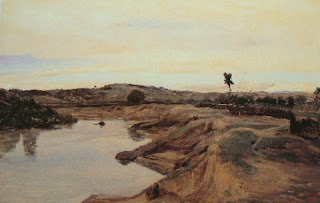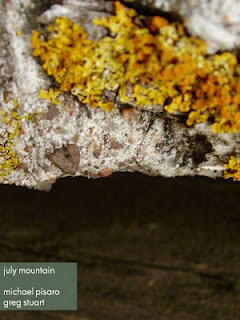'We live in a constellation / Of patches and of pitches' wrote Wallace Stevens in 'July Mountain'. This poem is the starting point for Michael Pisaro's recent collaboration with percussionist Greg Stuart, which I've been listening to this week, along with
A wave and waves, an earlier poetry and landscape inspired piece.
July Mountain starts with 'patches and pitches' of environmental sound and until a striking moment, eight minutes in, when you hear the first note of a piano. As the piece builds the natural sounds fade and the percussion intensifies (the effect is powerful but is a bit like listening to a hoover). Several people have already written posts about
July Mountain but the best description is by
Yuko Zama - here is an extract:
'From the start, some environmental sounds like falling rain, birds chirping, distant voices of people, airplanes flying overhead and cars passing by are heard. Despite this being a mixture of field recordings made at ten different locations, the sounds are all nicely blended as if they were sharing the same time and space, without causing any chaos or discordance, perhaps due to the delicately controlled balance of the individual volumes. At this point, any percussion sounds are barely recognizable.Then as time goes by, more environmental sounds like helicopters, calls of sea gulls, and waves (as well as many other almost unrecognizable sounds) appear in the soundscape. Since the transition between field recording sources is so natural and subtle, there is no impression that one field recording is switched to another at all. It is rather like the landscape and the time you are in is slowly and endlessly shifting to somewhere else almost before you realize it. About eight minutes in, one strong, determined piano chord is added in the middle of the environmental sounds. The appearance of this piano chord changes the atmosphere of the whole soundscape...'
Brian Olewnick, on his
Just Outside blog, describes 'letting "July Mountain" cascade over you. The sounds begin quietly with birds, wind, the low throb of an airplane engine, etc. and gradually mass into an onrush that remains strangely delicate for all its force. The piano, children's voices, sine tones, light metallic clatter and much more begin to funnel into an ever widening vortex that absolutely sucks you in while always providing oxygen. It's as if you're sitting on the mountain or in that valley having had your ears hyper-sensitized so they were picking up every sound within miles and, more, making a kind of sense of them, collating them into a semi-recognizable pattern.'
The latest
Wire has an interview with Pisaro in which Philip Clark asks him about a persistent worry with field recordings - that you can just stick a microphone in the landscape and call the result 'art'. For his part, Pisaro points to the importance of the way an artist selects and frames nature (true of all landscape art) and Clark agrees, citing
July Mountain, which is based on 'the pre-compositional strategies of a graphic score.' The instructions future versions are: '20 recordings may be made by the performer(s) or obtained from the composer. They should all be made in mountain areas or valleys if possible. See the attached chart for the arrangement of the recordings in time, panning, and information about the fades...' You can download the score from the Jez riley French site and see how precisely programmed the percussion is, e.g. 10 bells + beating sine tones (13 sounds) starting at 15:30 with duration 20", using bell numbers 1 and 2; 1, 2 and 4; 3; 1, 2, 3 and 4 etc.
A wave and waves (2007) has no environmental sounds - it is an orchestral piece in two parts, scored for 100 percussion instruments. The title is a clue to the influences - John Ashbery's poem 'A Wave' and the sound pattern of waves at Big Sur, California. At the moment, I think I prefer it to
July Mountain. Part I, 'a world is an integer', is a single, cresting wave and Part II, 'a haven of serenity and unreachable', was inspired by Pisaro's observance of the waves at Big Sur, arriving with a periodicity of 15-20 seconds where "every seventh wave would be a 'big one'". Here is another extract from the writing of
Yuko Zama, emphasising the connection between the music and natural sounds:
'The pure straight tones in different pitches, created by bowing various musical instruments, evoke the horizontal vastness and a slow, gradual move of a single wave. Meanwhile, the fine particles of small grainy sounds, created by the showers of rice, seeds and pebbles falling on various materials or simply from ripping paper, evoke the image of a microscopic world inside the wave - where thousands of small bubbles and swirls of water constantly emerge and disappear. The layer of the various sounds with different textures creates a stereoscopic effect and a realistic perspective for the whole soundscape, resulting in the lifelike impression of a single wave slowly and silently surging from a far distance. The whole sound also evokes a feeling of floating in space, as if I were watching small stars glowing in the dark - appearing one by one in the galaxy, slowly passing by each other, then disappearing into the dark.'




